#bamboo fabrics
Text
#online fabrics#online fabric shopping#online fabric material#fabric by the yard#organic cotton material#organic cotton textiles#best cotton fabric in india#annatto powder#organic corduroy fabric#hemp textiles#organic fabric material#bamboo fabrics#khadi silk material#bamboo fibre fabric#khadi silk fabric#khadi cotton fabric#muga silk#khadi silk cloth#swatch book#silk khadi fabric#silk muga#khadi fabrics#corduroy fabric#fabrics wool#ahimsa silk#white fabrics#is silk vegan#dyeing sarees#tussar silk saree plain#corduroy material
0 notes
Text
Yarn Dyed Fabrics
Yarn Dyed Fabrics: Where Artistry Meets Textile Innovation
Yarn dyed fabrics are a testament to the artistry and craftsmanship that elevate textiles to a whole new level. Unlike printed fabrics, where the design sits on the surface, yarn dyed fabrics are woven with threads pre-dyed in distinct colors, creating patterns and designs that run through the entire fabric. This results in a depth and richness of color that remains vibrant over time, making every garment or home textile a work of enduring beauty.
The meticulous process of yarn dyeing ensures that each thread is saturated with pigment before weaving, offering a longevity of color that resists fading. Whether it's classic stripes, intricate plaids, or intricate checks, yarn dyed fabrics bring a timeless and elegant aesthetic to your fashion or home decor. They are the preferred choice for those who seek quality and style that goes beyond the surface.
Choose yarn dyed fabrics for a touch of sophistication and textile excellence, where every thread tells a story of dedication to quality and design.
#organic cotton material#organic cotton textiles#best cotton fabric in india#annatto powder#organic corduroy fabric#hemp textiles#organic fabric material#bamboo fabrics#khadi silk material#bamboo fibre fabric#khadi silk fabric#khadi cotton fabric#muga silk#khadi silk cloth#swatch book#silk khadi fabric#silk muga#khadi fabrics#corduroy fabric#fabrics wool#ahimsa silk#white fabrics#is silk vegan#dyeing sarees#tussar silk saree plain#corduroy material#khadi fabric#khadi cloth material#ahimsa silks#linen fabric online
0 notes
Text
Fabric types and summer heat
The world is seeing record temperatures again. A lot of people find little comfort in their summer wardrobe these days, so it's important to be aware of how fabric types can influence your well-being in hot weather.
The following list of fabrics is by no means exhaustive, but it covers the basics.
Some of the fabrics mentioned below are expensive when bought new. You'll often find them for cheap in second-hand shops and on thrifting platforms though. I'm literally wearing a €5 linen underskirt, a €1 silk top, and a €7 silk summer dress right now, just to give an example.
General notes:
If you don't know where to start, try to stick to light-weight fabrics made of natural fibres. Look for light colours and open weaves.
You might be tempted to cover as little skin as possible in order to keep cool, but this leaves your skin vulnerable to sunburn. A thin layer of linen will often be more efficient at keeping you cool than leaving your skin bare.
Don't forget to wear sunscreen! Even if your skin type doesn't burn easily, it will still lower your chances of skin cancer. Look into sunscreens for children if you have sensory issues: they tend to be more sensory-friendly.

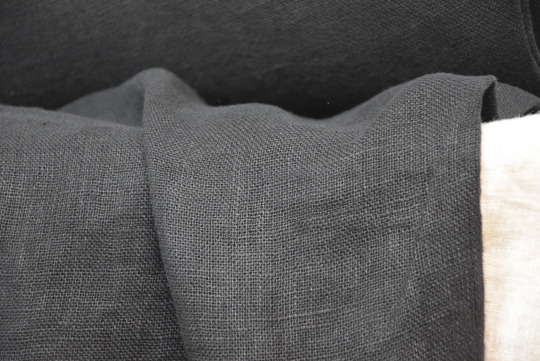
(Image source 1) [ID 1: a gray linen fabric with a tight weave.] / (Image source 2) [ID 2: a gray linen fabric with a loose weave.]
Polyester (to avoid):
Are your summer clothes making you ridiculously sweaty? Check the tag: you're probably wearing polyester.
Polyester is a synthetic fabric derived from petroleum: it's basically a plastic. It's strong, cheap, and stain resistant, which makes it a popular fabric. Even though a lot of summer clothes are made out of polyester, it's one of the worst fabrics to wear in summer.
Polyester is neither absorbent nor breathable, and captures heat. It traps sweat between your skin and your clothes, and it won't let you cool down. This leaves you feeling sticky and overheated. It can also cause static cling, which can be uncomfortable.
Not all synthetic fabrics are bad in summer: a lot of UV-blocking clothes are made of synthetics for example and can be a real life saver if you're sensitive to the sun. Try to avoid polyester if you can, though.
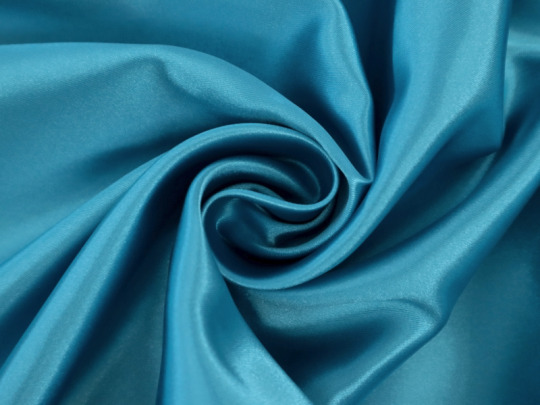
(Image source) [ID: close-up on a blue tightly woven polyester fabric that folds into a swirl at its centre.]
Cotton:
Cotton is a natural fibre that makes for a soft, durable, and breathable fabric. It allows air to circulate around your body which helps to keep you cool and get rid of sweat. It's a good basic choice.
Cotton has one downside: it's very absorbent, but takes a while to dry. If the weather's making you sweat excessively, the sweat can pool into the fabric of your cotton clothes. This will make them wet, resulting in visible sweat stains that can feel uncomfortable and will take a long time to dry.
If you can't stand how cotton feels, check out chambray weaves or bamboo textiles. They have similar properties to plain-weave cotton, but tend to be more sensory-friendly.
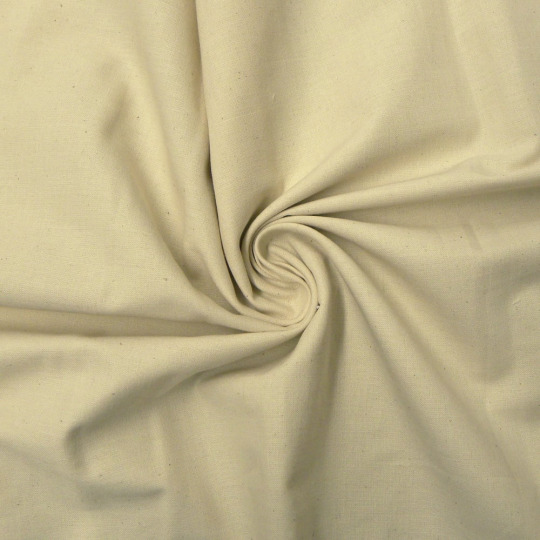
(Image source) [ID: close-up on a faded yellow tightly woven cotton fabric that folds into a swirl at its centre.]
Linen:
Linen is the absolute king of hot weather fabrics. It's strong, absorbent, dries quickly, and is very breathable. It cools you down, but won't make you feel sticky because any sweat it absorbs will evaporate fast.
I frequently layer multiple thin loose-fitting linen garments when it's hot. Loose layers allow for air to circulate between your clothes while protecting your skin from the sun. It almost functions as a wearable air-conditioner.
Note that linen is prone to wrinkling. If this bothers you, know that linen requires extra effort during laundry to avoid this.
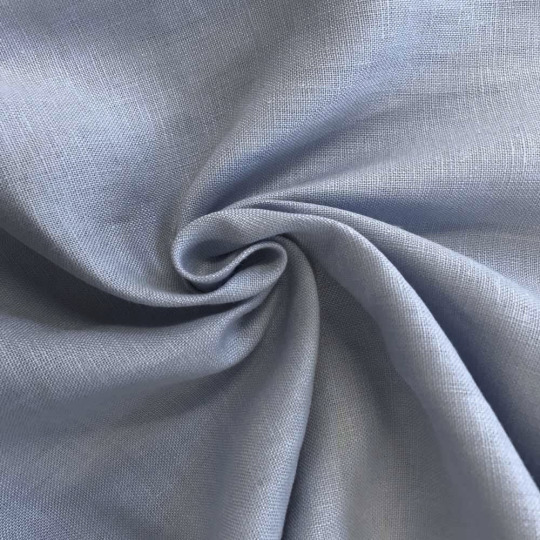
(Image source) [ID: close-up on a gray woven linen fabric that folds into a swirl at its centre.]
Silk:
Silk is yet another natural fibre that makes for a strong, quick-drying, and pretty breathable fabric. It's soft and cool to the touch, which makes it a great sensory choice.
Silk is not as breathable as cotton or linen, but dries very quickly. This means it might make you sweat more than cotton or linen does, but once the fabric's moist it will dry faster.
Note that sweat stains on silk tend to be pretty visible. Silk's also prone to static cling.
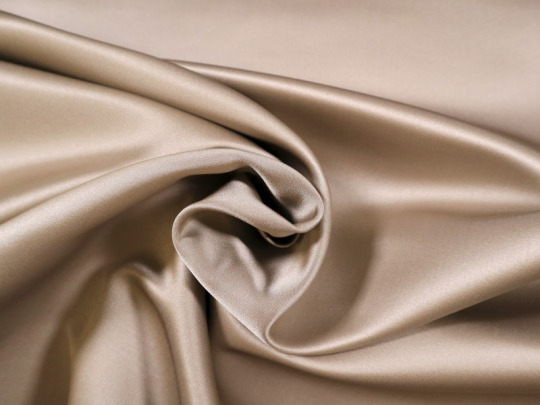
(Image source) [ID: close-up on a light brown tightly woven silk fabric that folds into a swirl at its centre.]
#wasteless crafts#fabric#summer#hot weather#sweat#fibres#silk#linen#polyester#cotton#chambray#bamboo#fabric types#fabric properties#clothes#fashion#keeping cool#heat waves#sunscreen#weather#thrifting#second hand shopping#fast fashion#slow fashion#sustainable fashion#uv blocking fabrics#tw cancer mention#tw skin cancer
2K notes
·
View notes
Text
In my quest to be a mediocre knitter, I started with twenty stitches after my cast-on and ended with twenty-two
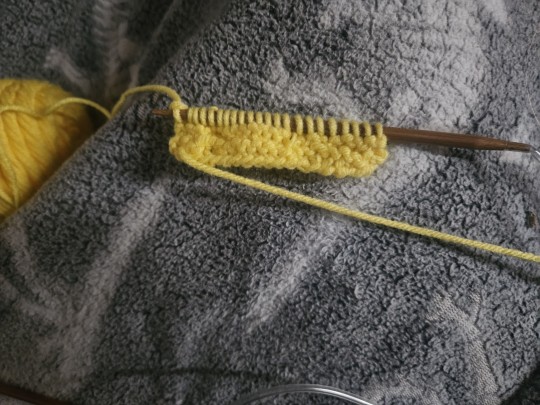
#art#fiber art#knit#described images#image description in alt#somebody described what needles you ought to use if you are a loose or a tight knitter and i didnt get it and now. i do.#my knit stitches are. incredibly tight. and it's hard on these bamboo needles#somebody else described knit as crochet but with all the loops being active and not completed and. yeah actually#i looked at the bottom of the swatch and it's really similar to the foundation chain i'd use for crochet#part of my struggle is not holding the yarn at all. i'm using english style (throwing the yarn over) but i'm not holding it at all LMAO#i still prefer crochet so far but knit fabric is very nice compared to crochet fabric#i love how colour changes look on knitted fabric. i feel crocheted fabric is a bit bulky due to the nature of crochet#crochet is still easier i think
83 notes
·
View notes
Text

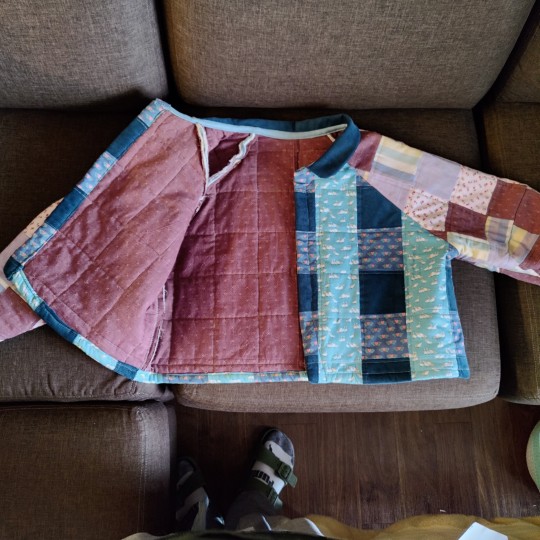

finished my patchwork jacket 😁😁
#this was such a perseverence project i've never quilted anything so sewing the patches and quilting and sewing the pattern... omg....#my goal is to be more sustainable with clothes shopping habits so now if i want something i have to make it vidkkskcjs#i want to remove as much polyester as possible so this is all cotton / linen / bamboo#i got some fabrics from a thrift store and the rest from my local sewing shop. very excited to sew more! i haven't sewn much in years!#salad dad#my art
16 notes
·
View notes
Text

Swatch sample 'Smallstem' of block-printed cottons and linens.
#block-print#block-printing#william morris#kate faulkner#john henry dearle#smallstem#ok here i go trying to identify chinoiserie floral motifs#peony#chinoiserie#bamboo#rose#spring blossom#spring blossoms#plum blossom#arts and crafts movement#fabric#cotton#linen
29 notes
·
View notes
Photo
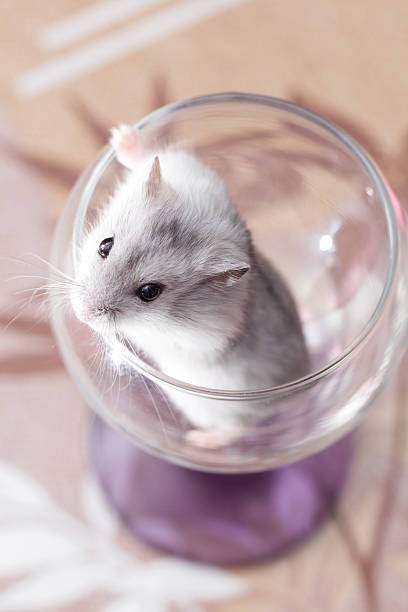

images by istockphoto
#purple bottom#clear top#wine glass#hamster#dwarf hamster#bamboo#bamboo fabric#bamboo print#brown and purple
54 notes
·
View notes
Text
whatever it turns out there are actually no weighted blankets in the world that are queen sized and breathable and 10-15lbs and also the one i bought has inner pockets that are too big? so the beads hang to one side. and it does cost to return it after all if you read the fine print? so i think im going to. A. hand quilt smaller pockets of the filling so the weight distributes evenly for real. and or B. carefully chop it down and rebind it to make it smaller and lighter. or sew some strips of the pockets to another blanket. or. C. i could destitch the whole thing and redo the pockets and glass bead distribution to be less weight 🤗🤗🤗🤗🤗🤗 <- guy who is insane enough to do that
#ok so the thing is. if i bought enough cotton/bamboo blend fabric to make a new blanket it would cost like 70 dollars.#not even counting beads. idk how much beads would cost hang on let me google something.#40 to 60 dollars??????????? oh fuck no!!!!#damn!!!!#if i hang on to this blanket i will save money on supplies fr fr
5 notes
·
View notes
Photo
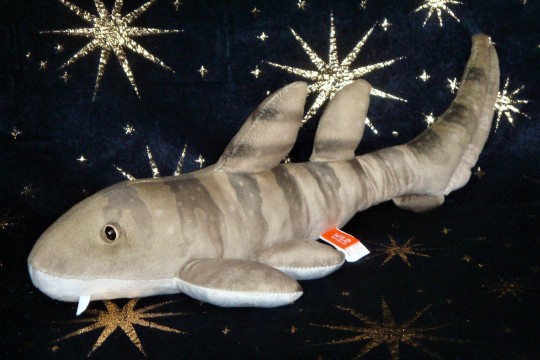
Bamboo shark by Wild Republic, bought at Dynamic Earth gift shop in Edinburgh in July 2021
#bamboo shark#shark#Wild Republic#plushie#toys#grey#beige#natural colour#printed fabric#sea creature#fish
75 notes
·
View notes
Text

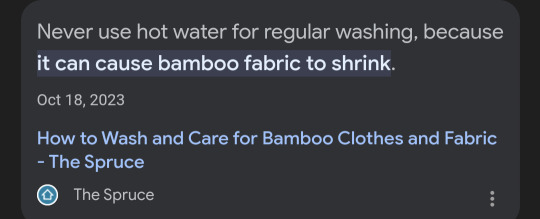


genuinely what is the truth
#reddit statements are about a hand knit sweater where the google suggestions are about commercial knit bamboo fabric.. would it make that#much of a difference!?!?#between it shrinking or literally GETTING BIGGER ???
2 notes
·
View notes
Text
Best Eco-Friendly Textiles Solution For Your SS24 Collection
Suvetah's philosophy is "slow and soulful," crafting environmentally friendly textiles that whisper tales of sunshine-kissed fields and whispered promises to the planet. Because SS24 isn't just about what you wear, it's about who you are. It's about embracing a future where fashion and the planet dance hand-in-hand, where style and sustainability tango under the summer sun. And Suvetah's got the soundtrack for this eco-chic revolution.

Organic cotton remains a reliable go-to for its breathability, comfort, and versatility. Grown without harmful chemicals and pesticides, it uses less water and land, making it a gentle giant in the textile world. Plus, organic cotton comes in a variety of weights and textures, perfect for everything from breezy sundresses to crisp shirting. Look for GOTS (Global Organic Textile Standard) certification to ensure the highest ethical and environmental standards.
2. Hemp: The All-Natural Powerhouse

3.Organic Double Gauze: Breathable Bliss

Double gauze deserves a special mention in the sustainable fabric sphere. Made from two layers of lightweight organic cotton loosely woven together, it retains the benefits of cotton- breathable, soft and comfortable while adding a delightful crinkled texture and extra airiness. Think floaty summer dresses, billowy blouses, and ultra-soft baby blankets. Plus, double gauze gets softer with every wash, adding a touch of vintage charm to your wardrobe. Brands like Kokka Fabrics and Vritti Designs offer stunning organic double gauze options in a rainbow of colors, perfect for those breezy summer days
4. Kala Cotton: Natural Beauty with an Eco-Conscious Soul

Hailing from the sun-drenched deserts of Kachchh in Gujrat, India, Kala cotton is more than just a fabric; it's a story woven into every thread. Most people think that this cotton is black because of its name, Kala, which means black in most Indian languages. But its name refers to the boll that remains after extracting the cotton fibre. It will always be pure in form and not like other kinds of cotton, such as regular cotton.
5.Banana fabric
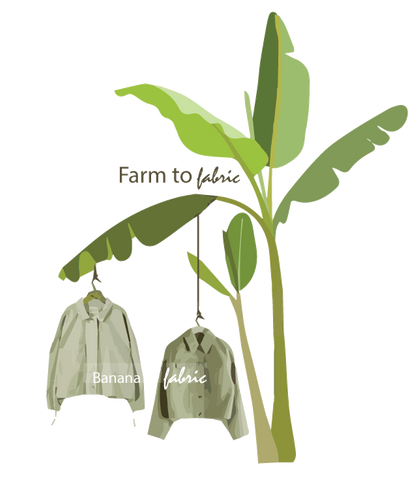
Banana fabric isn't made from the fruit itself, but from the fibers found in the stem and peels of the banana plant. These fibers are surprisingly strong and versatile, making them perfect for weaving into textiles. The process starts by extracting the fibers from the plant, which can be done through various methods depending on the desired result. Once extracted, the fibers are spun into yarn and then woven into fabric.we can expect to see banana fabric become more widely available and used in a variety of clothing and accessories. With its sustainable credentials and unique properties, banana fabric is sure to be a major player in the future of eco-friendly fashion.Share
Back to blog
#organic cotton material#cotton knit fabric#hemp cloth#hemp as fabric#bamboo fabrics#khadi silk material#white fabrics#hemp for clothes#khadi silk cloth#silk khadi fabric#khadi silk fabric#hemp for clothing#ahimsa silk#khadi fabrics#cotton fabrics#sustainable fabric
0 notes
Text

4 notes
·
View notes
Text
Could left-handed artists be given some love and get left-handed artist gloves? I keep finding right-handed ones only.
I have been using fingerless winter gloves to draw on my iPad.
I stg if I gotta make one myself I will
Edit: I forgot to clarify, fingerless winter gloves as in: The one's that are regular gloves but with the fingerless ones on top. I took them off because they're cool and I hate the feeling of the normal pair on my fingers
#wen posts something#my aunts dog got my glove that I forgot to put into my pocket and I'm bummed about it#but it got me thinking into getting an actual glove meant for digital art#if i can't find one im gonna use an old shirt for fabric and fuck around on the sewing machine#because it feels unfair#just for my ipad until i can manage to buy a cintiq (my bamboo wacom isn't gonna last forever)
2 notes
·
View notes
Text
saw fabric misinformation on twitter and now im going to be mad all day about it
#'bamboo fabric' is rayon with unreasonably good PR#rayon is great in that it feels great its cheaper than silk it drapes great and it biodegrades. it's a fascinating fiber#rayon also has a very chemically wasteful and energy intensive manufacturing process#your search for a magically unproblematic cheap fiber is in vain sorry#just reuse the fabrics that already exist as much as you can thats the real key to sustainability!!!#anyway#what working at a fabric store for 2 years does to a mf
4 notes
·
View notes
Text
Browse Our Most Comfortable Women's Hemp Clothing Australia
Are you tired of buying cheap clothes? Tantrika is a brand that supports sustainable practices, fair trade and quality garments. The hemp fibres are durable enough for durability but soft enough to feel great against your skin. It wicks moisture from your body like no other fabric, so you never have to worry about feeling sweaty or uncomfortable. Our range of clothes is made from top-quality materials and incorporates the superior properties of hemp fibre. We love that hemp is the only natural fibre that can absorb and release moisture without feeling wet or clammy. Contact us for more details about Women's Hemp Clothing Australia.

#mens shirts online australia#eco friendly clothing australia#women's underwear australia#feather earrings online#crystal lamps australia#organic hemp fabric australia#women's bamboo underwear australia#linen tee womens#bamboo clothing australia online
4 notes
·
View notes
Text
youtube
Join me on a foraging trip in my new PNW neighborhood forest filled with plants ready to share their natural colors. A short walk through Lake Stickney Park reveals wonderful dye sources from evergreen bark, needles & cones, bramble, birch, alder, wild geranium, lilac, dandelion, lichen, holly and fern. We'll even cut a few fronds to bring back to the dye studio! This tutorial will show you how to identify local forest dye plants & brew dye from foraged fern, including the resulting color swatch samples (cotton, bamboo & silk).
CHAPTERS
0:00 Introduction - Springtime foraging in Lake Stickney Park
1:40 Evergreens
4:42 Bramble
5:16 Alder
5:49 Picture This & Geranium
6:46 Lichen
7:27 Salmonberry
7:52 Birch
8:58 Lilac
9:28 Dandelion
9:39 Oak Moss
9:57 Pine
10:33 Holly
11:39 Fern
12:36 How to make fern dye
14:06 Thoughts on electric stovetop
15:24 Color samples on cotton, bamboo & silk
15:44 Wrap up
17:31 Sneak peak of next tutorial
18:04 Blooper
SUPPLY LIST
Fern
Pruners/Scissors
Basket
Gloves
Pot with lid
Cutting board
Strainer
Spoon
Tongs
Textile - pretreated with mordant
#Margaret Byrd: Color Quest#solarpunk#dye#natural dye#how to#how to dye#diy#do it yourself#fern#ferns#Lake Stickney Park#cotton#bamboo#silk#fabric#cotton fabric#bamboo fabric#silk fabric#Youtube
4 notes
·
View notes